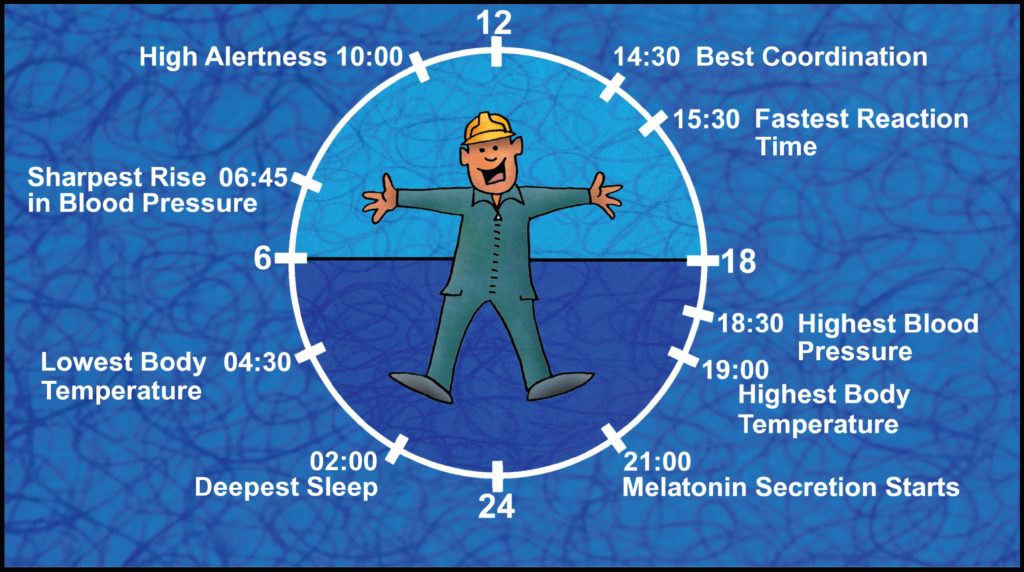The term ‘circadian’ comes from the Latin circa meaning around, and diem meaning day. Our bodies go through a fairly predictable series of processes in the cycle of a day. This natural rhythm results from a biological clock located in the hypothalamus of the brain, and its activity is known as the circadian rhythm. There are clear patterns of core body temperature, brain-wave activity, hormone production, cell regeneration, and other biological activities involved in the process of daily fluctuations that occur in this cycle. These 24-hour rhythms can be observed, not only in humans, but also in plants, animals, and other forms of life.
Why might this information be important to shift-workers? By nature, humans are active. We perform best during the day, and need to sleep at night when performance is generally poorer. Shift-workers are required to perform well and remain alert both day and night, depending on the schedule. Our internal body clock can change gradually, but for most people it is resistant to the abrupt changes in the sleep/wake cycle required by shift-work schedules. This can cause our natural daily rhythms to become out of step with those around us. The physical adjustment of our internal body clock to an abrupt change in the sleep/wake cycle may take days or weeks. Body functions will start to adjust after a few days of shift work, but at different rates, so behaviors that rely on a regular cycle such as digestion, alertness, and sleep are disturbed. Those who maintain a lifestyle of working rotating shifts must be very intentional about getting the rest and nutrition they need to enjoy good health.
Light is the main cue that tells your body to be awake in daylight hours. Even on day shift, a dip in energy levels can be expected in late afternoon. It’s referred to as a circadian trough. Knowing this dip in energy will occur after lunch, it’s imperative to prepare to avoid drowsiness. If possible, take a walk away from the console or do alertness exercises at the console, drink a bottle of water, or a cup of coffee or tea. Even a light snack can help a tired worker through the afternoon lull.
Because light stimulates your brain to wake and be alert, it’s important to shield your eyes from the rising sun when coming home from working night shift. Sunglasses, a hat, and your car’s visor can all be helpful in keeping bright light from your eyes. Cover windows with blackout shades at home to simulate darkness. Blocking light from your environment as much as possible is one of the best ways to avoid the natural rhythm of daytime alertness in the biological clock.
Most shift-workers also experience a slower metabolism at night. This is when the brain sends signals to the body to slow the digestive system and lower the body temperature. Those working night shift may find it helpful to eat smaller meals that contain both protein and carbohydrates to maintain energy levels and alertness throughout the shift. It’s also important to consume only moderate levels of caffeine while on night shift. The combination of high levels of caffeine and the light of early morning, may impede sleep once the night shift is over.
With planning and preparation, shift-work and the adjustments in between rotating shift schedules can be managed more successfully. Enjoying sufficient quantity and quality of sleep, choosing healthy foods and food portions, actively managing the circadian trough, and protecting your biological clock’s vulnerability during off-shift hours are key!
MANAGING FATIGUE EDUCATIONAL PROGRAM | Scarlet Knight © 2019 Please Distribute to Others.




